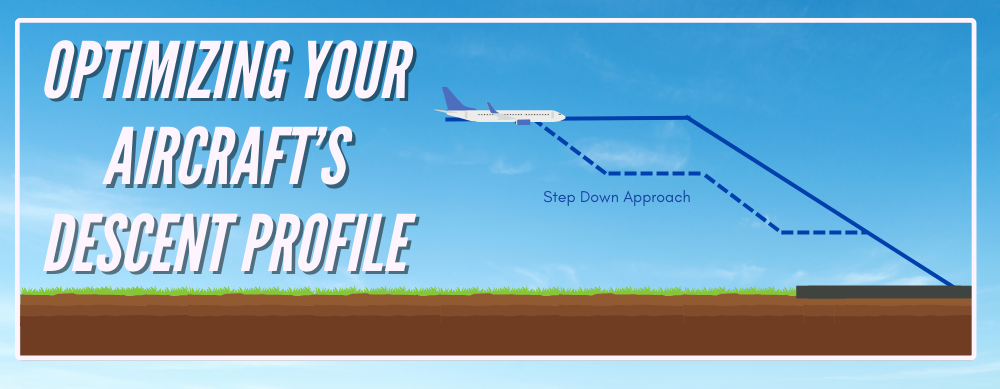É importante garantir que suas operações de voo sejam econômicas e seguras; uma grande parte disso é planejar sua descida.
Se você se concentrar em ter um caminho vertical preciso da altitude de cruzeiro até o pouso, criará uma viagem agradável e fácil para seus passageiros, economizará combustível, reduzirá as emissões e atenderá aos protocolos do ATC.
Procedimentos modernos como a Abordagem de Descida Contínua (CDA) lhe dão o poder de gerenciar suas descidas de maneiras realmente inovadoras.
Quer saber mais? Bem, continue lendo e eleve essas habilidades de planejamento de descida.
RESUMO
-
Você torna seu voo mais seguro e econômico planejando uma descida precisa.
-
A regra 3:1 e a taxa de descida baseada na velocidade no solo ajudam a manter uma trajetória de planeio suave.
-
As aproximações de descida contínua economizam combustível, reduzem as emissões e diminuem a poluição sonora.
-
Fatores como peso da aeronave, vento e restrições do ATC influenciam seu perfil de descida.

Compreendendo o Perfil de Descida
A primeira coisa que você pode estar se perguntando é: o que é um perfil de descida? Bem, o perfil de descida de uma aeronave é o caminho de voo vertical predeterminado que a aeronave segue ao fazer a transição de cruzeiro para um pouso bem-sucedido.
O objetivo deste perfil é atender a vários objetivos críticos:
-
Segurança: você vai querer manter uma distância adequada do terreno e dos obstáculos, além da altitude correta.
-
Uso de combustível: É melhor reduzir mudanças desnecessárias no empuxo do motor e minimizar o consumo de combustível.
-
Conforto do Passageiro: Você não quer que seus passageiros tenham estômagos desconfortáveis. Uma descida suave evita mudanças bruscas de altitude.
-
Conformidade com o ATC: seguir procedimentos e instruções estabelecidos mantém você em conformidade.

Componentes de um perfil de descida
Agora que entendemos o perfil, precisamos dividir seus componentes:
-
Topo da Descida (TOD):
O TOD é o ponto de descida específico onde você, o piloto, inicia a descida do cruzeiro em voo reto e nivelado. Calcular esse ponto com precisão é vital se você quer ter uma transição suave. -
Taxa de Descida (ROD):
Isso é expresso em pés por minuto (FPM), o ROD é a velocidade de descida na qual a aeronave perde altitude. Um ROD ótimo significa que sua descida permanece organizada sem comprometer a segurança ou o conforto. -
Ângulo de descida:
A maioria das descidas é planejada em torno de um ângulo padrão — normalmente cerca de três graus — o que proporciona uma trajetória de planeio consistente até a pista.

Calculando seu perfil de descendência
Descobrindo o topo da descida
Uma boa e comum regra de ouro usada por pilotos é a regra 3:1 . A fórmula para estimar a distância do destino para começar a descida é:
Distância para TOD (em milhas náuticas) = (Altitude atual - Altitude alvo) × 3 ÷ 1.000
Vamos tentar simplificar. Por exemplo, se uma aeronave estiver voando a 12.000 pés e a altitude alvo for o nível do mar (0 pés), o cálculo seria:
(12.000−0)×3÷1.000=36 milhas náuticas
Isso significa que a descida deve começar aproximadamente 36 milhas náuticas do aeroporto de destino.
Como estabelecer uma taxa de descida
Para manter uma trajetória de planeio de três graus, outro cálculo simples é usado para a taxa de descida.
Multiplique a velocidade no solo (em nós) por 5. Vamos fazer um exemplo, se a velocidade no solo da aeronave for 110 nós:
110×5=550 pés por minuto
Este método ajuda os pilotos a atingir a melhor razão de descida.

Aproximação Descendente Contínua (CDA)
Os pilotos podem escolher a Aproximação de Descida Contínua (também conhecida como Descida de Perfil Otimizada ou OPD) para ajudá-los a modernizar seus procedimentos de descida.
Em vez de seguir a tradicional descida em escada — onde você desce em vários degraus, liga os motores e depois nivela — eles seguem um caminho de descida agradável e ininterrupto.
Este método oferece várias vantagens:
-
Economia de combustível e redução de emissões:
Quando os aviões usam descidas contínuas, eles podem economizar milhões de galões de combustível a cada ano e reduzir significativamente as emissões de CO₂ e outras.Ao implementar novos procedimentos de OPD em aeroportos como Dallas-Ft. Worth e Orlando International, houve benefícios ambientais e operacionais substanciais.
-
Redução de ruído:
Quando os pilotos mantêm uma descida constante com seus motores em potência quase ociosa, eles produzem menos ruído do que fariam com um método tradicional de redução. -
Eficiência operacional:
Os pilotos reduzem sua carga de trabalho e facilitam a coordenação do ATC eliminando vários nivelamentos e ajustes de aceleração durante a descida.
Fatores que influenciam os perfis de descendência
Embora os cálculos básicos forneçam um ponto de partida, os pilotos devem considerar vários fatores ao planejar uma descida:
-
Peso da aeronave:
Aeronaves mais pesadas podem exigir ajustes na taxa de descida ou nas configurações de potência para manter a estabilidade. -
Condições do vento:
Ventos de cauda ou ventos contrários afetam a velocidade no solo, o que influenciaria tanto o cálculo do TOD quanto a taxa de descida. -
Instruções do ATC:
Os controladores podem impor restrições específicas de altitude ou velocidade para gerenciar o tráfego com segurança. Isso exigiria que os pilotos modificassem sua descida planejada. -
Terreno e Obstáculos:
O terreno local e os obstáculos devem ser considerados para garantir que haja espaço livre adequado durante a descida.
Procedimentos de descida da FAA
Em 13 de janeiro de 2022, a FAA implementou 42 novos OPDs (Perfis de Descida Otimizados) para reduzir o uso de combustível e as emissões de carbono durante a descida.
De acordo com o Secretário de Transportes dos EUA, Pete Buttigieg, esses procedimentos nos aproximam da nossa meta de atingir emissões líquidas zero da aviação até 2050.

Perguntas frequentes
-
Qual é a regra geral para descida de aeronaves?
Os pilotos costumam usar a regra 3:1 , que estima que para cada 1.000 pés de altitude perdidos, a descida deve começar a cerca de 3 milhas náuticas do destino.
-
Qual é a taxa de descida ideal?
Um método comum para determinar a taxa de descida ideal é multiplicar a velocidade do solo da aeronave (em nós) por 5. Por exemplo, a 300 nós, a taxa de descida seria de aproximadamente 1.500 pés por minuto.
-
Qual é a fórmula de descida 3:1?
A fórmula de descida 3:1 calcula a distância até o topo da descida (TOD) usando a equação:
Distância para TOD (em milhas náuticas) = (Altitude atual - Altitude alvo) × 3 ÷ 1.000
Esta estimativa rápida ajuda a manter uma descida suave.
-
Como você controla a taxa de descida?
Os pilotos controlam a taxa de descida ajustando:
Potência do motor: Reduzir o empuxo ajuda a diminuir a taxa de descida.
Pitch and Drag: Configurar a aeronave com flaps e ajustes de trem de pouso apropriados.
Coordenação ATC: Seguindo instruções precisas e fazendo ajustes em tempo real conforme necessário.
Remover
Agora você está armado com o conhecimento de como otimizar o perfil de descida da sua aeronave. Você precisa misturar vários fatores para atingir uma abordagem segura, organizada e ecologicamente correta.
Siga as dicas/etapas que compartilhamos e calcule o Topo de Descida, defina sua taxa de descida adequada e adote técnicas modernas, como a Abordagem de Descida Contínua.
Os pilotos podem reduzir o consumo de combustível, diminuir as emissões e proporcionar uma viagem mais tranquila aos passageiros.
Interessado em abordagens?
Nossos guias foram projetados para ajudar!
-
Abordagem visual versus de contato: principais insights para pilotos
-
Abordagem ILS: Sistemas de pouso por instrumentos explicados
Você achou este artigo útil?
Você acha que esquecemos de uma pergunta importante da entrevista? Deixe-nos saber nos comentários abaixo!





1 comentário
Don S
For rate of descent in small (slower) GA planes, I find it easier mental math to add a zero to the GS, then half of that for your target fpm rate. (this essentially amounts to multiplying by 10 and then dividing by 2, which turns out to be the same as multiplying by 5) . But for my mental math, it seems easier. Example speed 90. Add a zero (multiply by 10) and take half. So for example GS 70, is 350 fpm (half of 700); GS 90 is 450 fpm (half of 900), etc.